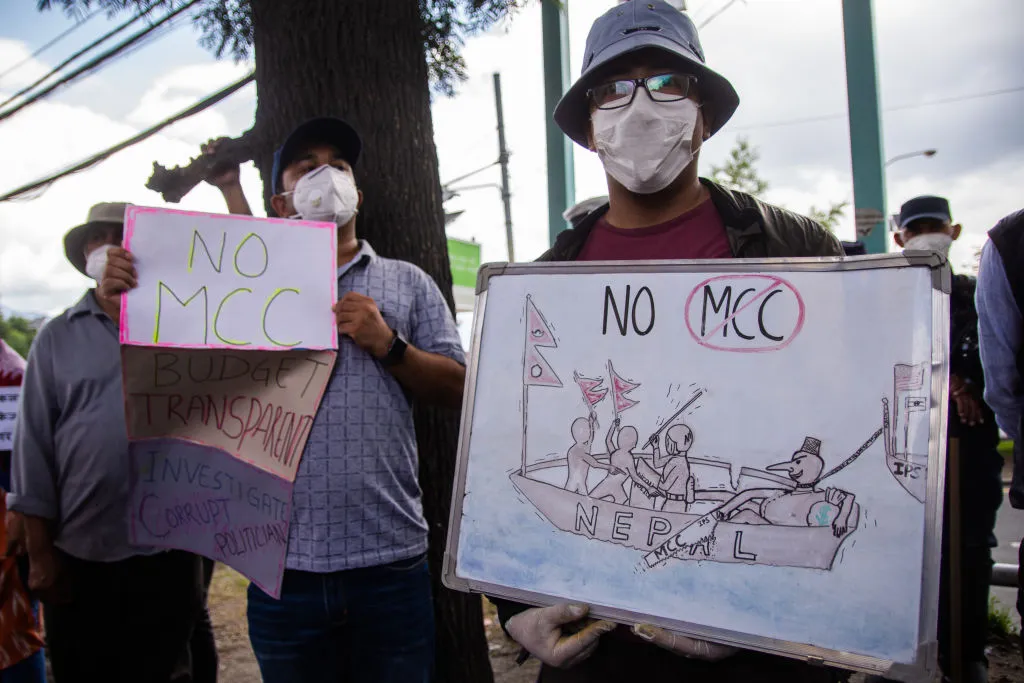
The Millennium Challenge Corporation (MCC), a bilateral United States (US) foreign aid agency, was established by the US Congress in 2004. The primary aim of this programme has been to provide substantial assistance to low- and middle-income countries, with the reduction of poverty and economic aggrandisement. In this regard various sectors are targeted like education, health, road and transport infrastructure, energy and agriculture as specific pillars of development, targeted for financial support. Since 2019, the MCC has approved 37 compacts worth US$ 13 billion, encompassing 29 countries.
Presently, the landlocked Himalayan country of Nepal has received an offer of partnership though it had been delayed due to indecision regarding its utilitarian aftermath in the long run. This has been doing rounds in policymaking circles, as Nepal’s apparent geostrategically non-aligned position in South Asia has been in jeopardy since the concept that was introduced indicated a direct liaison with the US. However, since Nepal was one of the first few countries that qualified for the compact, with 16 out of 20 policy indicators being met, years of debates and deliberations began to shape up in the country, fanning inter party political feud where they used this issue for their own benefit. Nonetheless, despite many apprehensions and speculations, the Nepalese Parliament finally ratified the compact after years of delay. In this regard, a 12-Point Interpretative Declaration was tabled, following which the MCC was endorsed.
Understanding the uneasy kernel
Nepal’s previous governing party—the Nepal Communist Party (NCP) was predominantly disunited on the matter of the MCC, under the leadership of KP Sharma Oli, who was then the Prime Minister of the country. It must be mentioned here that the offer to be a party to this bilateral negotiation had primarily come at the time when Nepal’s government was being headed by the Nepali Congress (NC). Synonymously, with the NC convalescing back to power, it was one of the very first affirmative bilateral standpoints that the country took, garnering much debate from the CPN UML. In fact, Oli was prompt enough to say that this issue was ‘a deliberate misinformation campaign’ after the MCC was formally adopted. He mentioned that “the controversy escalated in such a way that it neglected the capacity of the Nepali nation and Nepali self-esteem. It prompted the whole society to express hatred toward the leader who loves the country and dreams of the country’s development and prosperity”. Again, there are leaders like Narayan Man Bijjukchhe, Chairman of the Nepal’s Worker’s and Peasant’s Party who have accused the Chairman of CPN (Maoist Centre), Pushpa Kamal Dahal, of agreeing to the compact to protect himself from the wrath of the International Court of Justice. This was a consequence of several allegations against him following the death of several thousands of people during the civil war in Nepal, at the time of which Dahal was a Maoist rebel leader, moving on to become the Prime Minister.
Nepal was also wary of the compact’s clause of the MCC prevailing over the existing law of the land, if conflict occurs, this also, in turn, seemed deceptive to the people, despite the financial opportunities.
Moving forward, former Joint Secretary Baikuntha Aryal of Nepal and the Acting Chief Executive Officer of the MCC had signed an agreement in the presence of former Finance Minister Gyanendra Bahadur Karki and US Deputy Secretary of State, John Sullivan, in Washington. An aid of amount US $500 million was decided to be given to Nepal, of which US $130 million would be especially committed to the improvement of connectivity and the energy sector of Nepal.
Although the Standing Committee Meeting had concluded unperturbed, no constructive solution could be reached at. One of the crucial reasons for the scrutiny of the MCC was associated with the USA-Nepal misunderstanding as well as miscommunication regarding the latter’s Indo-Pacific engagement, which was overtly mentioned in the official Indo-Pacific doctrine of the US. This mention was outrightly denied by Nepal and was also not in favour of its geostrategic image as there was no formal announcement made prior to that. Since the MCC has been allegedly being forwarded as a part of the Indo-Pacific Strategic Report of the US, as elaborated by David J. Ranz, assistant Secretary for South Asia at the US State Department, how the compact will present Nepal in the global platform has raised questions and eyebrows. Additionally, there always lurks the threat of military assistance that the US might provide, apart from the economic agenda, creating apprehension and scepticism amongst the neighbouring countries.
Nepal is also in need of this impetus for growth after its economy slowed down post the earthquake and blockade of 2015, the COVID-19 crisis, and the vulnerable political scenario that seems to be never-ending in nature
Nepal is undeniably in a very sensitive position, even after the MCC has been given due acknowledgement in the country. With India and China keeping a close watch on the country and its ambitions, and is providing adequate opportunities for development like China’s Belt and Road Initiative (BRI), it is quite obvious that the country is treading carefully. Apart from this, Nepal was also wary of the compact’s clause of the MCC prevailing over the existing law of the land, if conflict occurs, this also, in turn, seemed deceptive to the people, despite the financial opportunities. In this matter, China reacted by just noting the formal significance of the compact at present and mentioning very overtly that it is against the ‘coercive diplomacy’ of the US and that the aspect should not include any political obligations.
Conclusion
The MCC compact may be considered indispensable to the bilateral relationship between the US and Nepal. Not only would it enhance is rapport with one of the most powerful countries of the world but also will enable it to achieve its middle-income status by 2030, as has been mentioned in the USAID documents as a primary affirmation. To be precise, Nepal is also in need of this impetus for growth after its economy slowed down post the earthquake and blockade of 2015, the COVID-19 crisis, and the vulnerable political scenario that seems to be never-ending in nature. In this dire situation, the MCC is also a chance to enhance its economic situation and to achieve self-reliance. On this accord, the relevance of the US in becoming a suitable partner in development is extremely crucial. Even though the time is ripe for Nepal to make the best use of this upward moving curve in the economic front, it must take care of its relationship with its immediate neighbours, which the country has been nurturing for decades now, in order to maintain its position as an important player, if not a buffer, in the region. More importantly, it is high time for Nepal to explore possibilities beyond the South Asian region and the extended neighbourhood for a better future.
The views expressed above belong to the author(s). ORF research and analyses now available on Telegram! Click here to access our curated content — blogs, longforms and interviews.




 PREV
PREV


